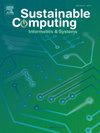利用关注卷积双向门控循环的改进风叶算法增强可持续农业:整合人工智能和物联网实现高效农业
IF 5.7
3区 计算机科学
Q1 COMPUTER SCIENCE, HARDWARE & ARCHITECTURE
引用次数: 0
摘要
可持续农业对于确保全球粮食安全,同时减轻对环境的影响至关重要。在农业实践中使用遥感数据和人工智能的可能性强调优化资源利用,最大限度地减少浪费,并培养有弹性的农业系统,以适应农业领域不断变化的气候条件。在利用遥感数据和人工智能进行疾病诊断和环境监测方面进行了多项研究,但由于巨大降雨和极端干旱等影响农业环境的扭曲和气候变化等因素,这些研究面临挑战。为此,本文提出了一种基于关注卷积双向门控递归的改进风叶算法,用于植物病害评估和环境监测。该算法利用多种数据集,包括PlantVillage、plantDoc、Soil Type、Advanced IoT Agriculture和IDADP,以及强大的数据预处理技术,如规范化、标准化和不平衡数据处理,对于完善数据集完整性和优化模型性能至关重要。此外,开发的模型结合了用于空间特征提取的卷积神经网络,用于顺序上下文建模的双向门递单元,以及融合了卷积神经网络和双向门递单元的注意机制,重点是通过对每个时间步应用加权模型来增加所提出网络的活动以获得最佳结果。此外,为了提高特征集成度,优化模型性能,该算法引入了Modified Leaf in Wind优化策略。通过实验验证,该方法在4种场景下均获得最佳性能,SC1的精度为97.5 %,SC2的精度为98.5 %,SC3的精度为96.9 %,SC4的精度为97.6 %。提出的模型使农民能够做出数据驱动的决策,从而提高生产率。本文章由计算机程序翻译,如有差异,请以英文原文为准。
Enhancing sustainable agriculture using attention convolutional bidirectional Gated recurrent based modified leaf in wind algorithm: Integrating AI and IoT for efficient farming
Sustainable agriculture is essential for ensuring global food security while mitigating environmental impacts. The possibilities of using remote sensing data and artificial intelligence in agricultural practices emphasize optimizing resource use, minimizing waste, and fostering resilient farming systems to adapt to changing climate conditions in the agriculture field. Multiple studies employed in utilizing remote sensing data and AI for diagnosing disease and environmental monitoring but they face challenges due to factors such as distortions and changes in climates like huge rainfall and extreme droughts affecting the farming environment. Therefore this article develops a novel Attention Convolutional Bidirectional Gated Recurrent based Modified Leaf in Wind Algorithm for assessing the disease of the plants and environmental monitoring. The algorithm leverages diverse datasets including PlantVillage, plantDoc, Soil Type, Advanced IoT Agriculture, and IDADP, and robust data preprocessing techniques such as normalization, standardization, and imbalanced data handling are essential for refining dataset integrity and optimizing model performance. Additionally, the developed model incorporates a convolutional neural network for spatial feature extraction, bidirectional gated-recurrent units for sequential context modeling, and attention mechanisms fuse the Convolutional Neural Network and bidirectional gated-recurrent units, focused on increasing the activity of the proposed network to obtain optimal results, by applying weighting model to each time steps. Moreover, to improve feature integration and optimize model performance, the proposed algorithm incorporates Modified Leaf in Wind optimization strategies. Through experimental validation, the proposed method procures the best performance in four scenarios with a precision of 97.5 % for SC1, 98.5 % for SC2, 96.9 % for SC3 %, and 97.6 % for SC4. The proposed model empowers farmers to make data-driven decisions that enhance productivity.
求助全文
通过发布文献求助,成功后即可免费获取论文全文。
去求助
来源期刊

Sustainable Computing-Informatics & Systems
COMPUTER SCIENCE, HARDWARE & ARCHITECTUREC-COMPUTER SCIENCE, INFORMATION SYSTEMS
CiteScore
10.70
自引率
4.40%
发文量
142
期刊介绍:
Sustainable computing is a rapidly expanding research area spanning the fields of computer science and engineering, electrical engineering as well as other engineering disciplines. The aim of Sustainable Computing: Informatics and Systems (SUSCOM) is to publish the myriad research findings related to energy-aware and thermal-aware management of computing resource. Equally important is a spectrum of related research issues such as applications of computing that can have ecological and societal impacts. SUSCOM publishes original and timely research papers and survey articles in current areas of power, energy, temperature, and environment related research areas of current importance to readers. SUSCOM has an editorial board comprising prominent researchers from around the world and selects competitively evaluated peer-reviewed papers.
 求助内容:
求助内容: 应助结果提醒方式:
应助结果提醒方式:


